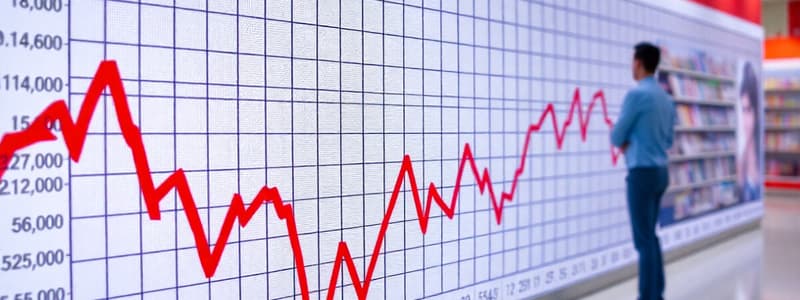Podcast
Questions and Answers
What is the primary purpose of classifying items in the CPI compilation process?
What is the primary purpose of classifying items in the CPI compilation process?
- To simplify the consumer's understanding of prices
- To define sub-aggregates that relate expenditure weights and prices (correct)
- To comply with international trade agreements
- To organize items based on price fluctuations
Which classification system has most countries adopted for their CPI?
Which classification system has most countries adopted for their CPI?
- HSN (Harmonized System of Nomenclature)
- CPC (Central Product Classification)
- COICOP (Classification of Individual Consumption according to Purpose) (correct)
- ISIC (International Standard Industrial Classification)
What percentage of the CPI is generally unaffected by changes in interest rates?
What percentage of the CPI is generally unaffected by changes in interest rates?
- 10-20%
- 25-30%
- 90-95% (correct)
- 50-60%
Which of the following aspects should influence the construction of a CPI?
Which of the following aspects should influence the construction of a CPI?
In the context of the CPI, what do fixed costs include?
In the context of the CPI, what do fixed costs include?
How can CPIs be made comparable across countries?
How can CPIs be made comparable across countries?
What is one of the misconceptions regarding the concept of CPI by households?
What is one of the misconceptions regarding the concept of CPI by households?
What is the significance of items organized under Groups, Categories, Sub-groups, and Sections in CPI?
What is the significance of items organized under Groups, Categories, Sub-groups, and Sections in CPI?
What effect does an increase in interest rates have on firms?
What effect does an increase in interest rates have on firms?
How does the appreciation of domestic currency affect net exports?
How does the appreciation of domestic currency affect net exports?
Which channel influences the access of firms and households to bank credit?
Which channel influences the access of firms and households to bank credit?
What happens to employment when domestic currency appreciates?
What happens to employment when domestic currency appreciates?
How does a decrease in interest rates generally impact consumer behavior?
How does a decrease in interest rates generally impact consumer behavior?
What occurs when the domestic currency depreciates?
What occurs when the domestic currency depreciates?
Which of the following is a possible consequence of high interest rates on household spending?
Which of the following is a possible consequence of high interest rates on household spending?
What is the primary impact of the credit channel on businesses?
What is the primary impact of the credit channel on businesses?
What is the primary effect of the RBI selling government securities during inflation?
What is the primary effect of the RBI selling government securities during inflation?
How does the balance sheet channel influence production when interest rates increase?
How does the balance sheet channel influence production when interest rates increase?
What happens to consumption and production when debt securities become more attractive than equity?
What happens to consumption and production when debt securities become more attractive than equity?
What does the Cash Reserve Ratio (CRR) represent in monetary policy?
What does the Cash Reserve Ratio (CRR) represent in monetary policy?
Which identifies the role of intermediate targets in monetary policy?
Which identifies the role of intermediate targets in monetary policy?
What is the primary goal of Quantitative Easing (QE)?
What is the primary goal of Quantitative Easing (QE)?
What effect does reducing the money supply have on firms that rely on bank loans?
What effect does reducing the money supply have on firms that rely on bank loans?
How does an increase in the Fed Fund Rates impact the RBI's decisions?
How does an increase in the Fed Fund Rates impact the RBI's decisions?
What is a key operating procedure of the central bank related to monetary policy?
What is a key operating procedure of the central bank related to monetary policy?
What does the standard asset price channel indicate about changes in credit policy?
What does the standard asset price channel indicate about changes in credit policy?
What is a consequence of a rising Fed Fund Rate for investors in India?
What is a consequence of a rising Fed Fund Rate for investors in India?
Which of the following correctly describes the action involved in Quantitative Easing?
Which of the following correctly describes the action involved in Quantitative Easing?
What effect does the Fed's monetary policy have on global capital flows?
What effect does the Fed's monetary policy have on global capital flows?
What happens to the borrowing costs when a central bank enacts Quantitative Easing?
What happens to the borrowing costs when a central bank enacts Quantitative Easing?
Which of the following describes the relationship between the Fed’s actions and the global borrowing market?
Which of the following describes the relationship between the Fed’s actions and the global borrowing market?
What is the impact of higher US interest rates on safe investments in the US?
What is the impact of higher US interest rates on safe investments in the US?
What does the US FED primarily seek to minimize and contain through active monitoring?
What does the US FED primarily seek to minimize and contain through active monitoring?
What type of agreement does the Federal Reserve engage in when it sells a security and agrees to buy it back the next day?
What type of agreement does the Federal Reserve engage in when it sells a security and agrees to buy it back the next day?
Which statement about WPI and CPI is not accurate?
Which statement about WPI and CPI is not accurate?
Under which scheme does the Government of India borrow from the RBI to absorb excess liquidity from large capital inflows?
Under which scheme does the Government of India borrow from the RBI to absorb excess liquidity from large capital inflows?
What is the primary purpose of the Federal Reserve System in conducting monetary policy?
What is the primary purpose of the Federal Reserve System in conducting monetary policy?
What does CPI primarily measure in relation to consumers?
What does CPI primarily measure in relation to consumers?
Which of the following describes WPI accurately?
Which of the following describes WPI accurately?
What is a key characteristic of non-tradables in the context of CPI?
What is a key characteristic of non-tradables in the context of CPI?
What is one of the main uses of the Wholesale Price Index (WPI)?
What is one of the main uses of the Wholesale Price Index (WPI)?
How does WPI differ from CPI in terms of the price collection level?
How does WPI differ from CPI in terms of the price collection level?
What is the weight of the food group in the Consumer Price Index (CPI) basket?
What is the weight of the food group in the Consumer Price Index (CPI) basket?
Why might price movements in the WPI basket not immediately affect the CPI?
Why might price movements in the WPI basket not immediately affect the CPI?
Which organization uses WPI as a deflator for estimating GDP?
Which organization uses WPI as a deflator for estimating GDP?
What type of goods does a significant proportion of the WPI item basket represent?
What type of goods does a significant proportion of the WPI item basket represent?
Which of the following is NOT included in the WPI basket?
Which of the following is NOT included in the WPI basket?
What is one reason for the divergence between WPI and CPI?
What is one reason for the divergence between WPI and CPI?
Flashcards
Interest Rate Channel
Interest Rate Channel
Monetary policy's impact on borrowing costs, affecting investment and consumer spending.
Exchange Rate Channel
Exchange Rate Channel
The influence of currency exchange rates on the prices of imported and exported goods, affecting trade.
Quantum Channel
Quantum Channel
Monetary policy's effect on the money supply and credit availability, impacting business and household borrowing.
Bank Lending (Credit) Channel
Bank Lending (Credit) Channel
Signup and view all the flashcards
Balance Sheet Channel
Balance Sheet Channel
Signup and view all the flashcards
Currency Devaluation
Currency Devaluation
Signup and view all the flashcards
Decline in Aggregate Demand
Decline in Aggregate Demand
Signup and view all the flashcards
Increase in Aggregate Demand
Increase in Aggregate Demand
Signup and view all the flashcards
Credit Restriction
Credit Restriction
Signup and view all the flashcards
Balance Sheet Channel Effect
Balance Sheet Channel Effect
Signup and view all the flashcards
Asset Price Channel
Asset Price Channel
Signup and view all the flashcards
Operating Framework of Monetary Policy
Operating Framework of Monetary Policy
Signup and view all the flashcards
Operating Target
Operating Target
Signup and view all the flashcards
Intermediate Target
Intermediate Target
Signup and view all the flashcards
Credit Policy Instruments
Credit Policy Instruments
Signup and view all the flashcards
Cash Reserve Ratio (CRR)
Cash Reserve Ratio (CRR)
Signup and view all the flashcards
Reserve Requirement
Reserve Requirement
Signup and view all the flashcards
Fed Funds Rate
Fed Funds Rate
Signup and view all the flashcards
US Interest Rate Impact on Global Markets
US Interest Rate Impact on Global Markets
Signup and view all the flashcards
Quantitative Easing (QE)
Quantitative Easing (QE)
Signup and view all the flashcards
QE's Impact on Interest Rates
QE's Impact on Interest Rates
Signup and view all the flashcards
QE's Impact on Money Supply
QE's Impact on Money Supply
Signup and view all the flashcards
Interest Rate Policy
Interest Rate Policy
Signup and view all the flashcards
Comparing Interest Rate Policy and QE
Comparing Interest Rate Policy and QE
Signup and view all the flashcards
What does the WPI measure?
What does the WPI measure?
Signup and view all the flashcards
How does the WPI help control inflation?
How does the WPI help control inflation?
Signup and view all the flashcards
What is a key use of the WPI in economic calculations?
What is a key use of the WPI in economic calculations?
Signup and view all the flashcards
How is the WPI used in business contracts?
How is the WPI used in business contracts?
Signup and view all the flashcards
What does the CPI measure?
What does the CPI measure?
Signup and view all the flashcards
What is the key difference between the WPI and the CPI?
What is the key difference between the WPI and the CPI?
Signup and view all the flashcards
What are some key differences between the WPI and CPI baskets?
What are some key differences between the WPI and CPI baskets?
Signup and view all the flashcards
Why might changes in the WPI not immediately reflect in the CPI?
Why might changes in the WPI not immediately reflect in the CPI?
Signup and view all the flashcards
COICOP (Classification of Individual Consumption according to Purpose)
COICOP (Classification of Individual Consumption according to Purpose)
Signup and view all the flashcards
Classification of Items in CPI
Classification of Items in CPI
Signup and view all the flashcards
Consumer Price Index (CPI)
Consumer Price Index (CPI)
Signup and view all the flashcards
CPI and Interest Rates
CPI and Interest Rates
Signup and view all the flashcards
CPI and Household Spending
CPI and Household Spending
Signup and view all the flashcards
CPI Relevance to Country Context
CPI Relevance to Country Context
Signup and view all the flashcards
Harmonizing CPI Classification with COICOP
Harmonizing CPI Classification with COICOP
Signup and view all the flashcards
Clear Definition and Naming of CPI Variants
Clear Definition and Naming of CPI Variants
Signup and view all the flashcards
WPI vs. CPI
WPI vs. CPI
Signup and view all the flashcards
Price Gap: WPI & CPI
Price Gap: WPI & CPI
Signup and view all the flashcards
Relative Price Trends: WPI & CPI
Relative Price Trends: WPI & CPI
Signup and view all the flashcards
The Fed's Role: Systemic Risks
The Fed's Role: Systemic Risks
Signup and view all the flashcards
Overnight Reverse Repurchase Agreement (RRP)
Overnight Reverse Repurchase Agreement (RRP)
Signup and view all the flashcards
Market Stabilization Scheme
Market Stabilization Scheme
Signup and view all the flashcards
Liquidity Adjustment Facility (LAF)
Liquidity Adjustment Facility (LAF)
Signup and view all the flashcards
Margin Standing Facility (MSF)
Margin Standing Facility (MSF)
Signup and view all the flashcards
Study Notes
Impact of Various Policies of Financial Markets
- Learning outcomes: Students will understand Credit Policy of RBI, Fed Policy, and Inflation Indices (CPI, WPI, etc).
Chapter Overview
- Credit Policy of RBI: Meaning, objectives, analytics, operating procedures, and instruments.
- Fed Policy: Meaning, objectives, analytics, operating procedures, instruments, impact on global financial markets, and quantitative easing.
- Cost Inflation Index: Concept, computation, and classification.
- Consumer Price Index: Concepts and computation, issues related to CPI.
- Wholesale Price Index: Introduction and differences between CPI and WPI
Credit Policy of the Reserve Bank of India (RBI)
- Meaning: A plan of action by RBI to control and regulate money demand and supply in India.
- Objectives:
- Maintain price stability (controlling inflation): RBI uses interest rates, increasing to cool down and decreasing to increase inflation.
- Achieve economic growth: A balance between price stability and economic growth is maintained.
- Exchange rate stability: Maintaining a stable exchange rate (e.g., reducing rupee depreciation).
Analytics of Credit Policy
- Mechanisms for influencing price level and national income:
- Interest Rate Channel: Higher interest rates decrease investment and spending. Lower interest rates increase investment and spending
- Exchange Rate Channel: Appreciation of domestic currency makes domestically produced goods more expensive
- Quantum Channel: Impacts firms' access to credit
- Asset Price Channel: Interest rate changes affect financial asset prices, impacting consumption, production, and employment.
Operating Procedure and Instruments
- Cash Reserve Ratio (CRR): The amount of money commercial banks must keep with RBI.
- Statutory Liquidity Ratio (SLR): The amount of money commercial banks must keep with themselves.
- Liquidity Adjustment Facility (LAF): Enables banks to borrow from RBI.
- Repo/Reverse Repo Transactions: Commercial banks borrow/lend to/from RBI via securities.
- Margin Standing Facility (MSF): An additional borrowing facility for commercial banks at a penalty rate.
- Market Stabilization Scheme: Used to absorb liquidity by government.
- Open Market Operations: Monetary policy tool to control liquidity by buying/selling securities.
Fed Policy
- About the Federal Reserve System: The central bank of the US.
- Fed Policy Tools:
- Open Market Operations: Buying/selling securities
- The Discount Rate: Interest rate charged to commercial banks
- Reserve Requirements: Reserve amount that depository institutions must hold against liabilities.
- Interest on Required Reserve Balances and Excess Balances Eliminates an implicit tax on required reserves.
Cost Inflation Index (CII)
- A measure of inflation used for computing long-term capital gains.
- Used for calculation of capital assets and the impact of inflation in their value.
Consumer Price Index (CPI)
- Measures changes in average retail prices of goods and services consumed by households.
- Used in inflation calculation and for price adjustments.
Wholesale Price Index (WPI)
- Measures the average change in prices of commodities for bulk sale at the early stage of transaction.
- Consists of Primary Articles, Fuel and Power, and Manufactured Products.
Studying That Suits You
Use AI to generate personalized quizzes and flashcards to suit your learning preferences.




